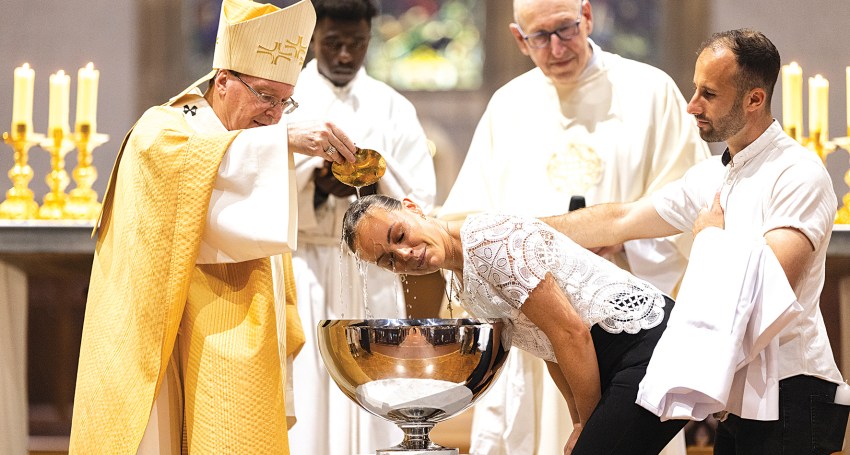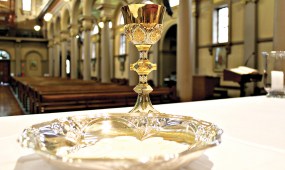
‘I saw water flowing from the right side of the temple, alleluia:
and all to whom this water came were saved and shall say:
alleluia, alleluia.’
Easter 2025
South Australia is gripped by one of the worst droughts in memory, even if we have had a few drops recently: lack of water. Widespread heavy rainfall from Tropical Cyclone Alfred has caused extensive flooding throughout central and western Queensland, with both the Diamantina and Cooper catchments receiving significant water. The Diamantina and Cooper are the two major water systems within the Lake Eyre basin which flow south-west towards Kati Thanda-Lake Eyre in South Australia: plenty of water. Drought and abundance at the same time.
Advertisement
The Vision of Live-Giving Water
Water is one of the dominant themes of the Easter liturgy. A lot happens at the Easter Vigil, and there are a lot of words. Little wonder that we might not take them all in.
This year at the Easter Vigil, as we sang the antiphon I saw water during the sprinkling with baptismal water I was struck both by how appropriate it was and the need to see water as ‘living water’. It is not just the flowing water for which we thirst, it is important to see it as living water.
This antiphon, I saw water, is grounded in the prophetic vision of Ezekiel (47:1–9), where water flows from the threshold of the temple and brings life wherever it reaches. Sung both at the Easter Vigil and throughout the Easter season, it places before us a profound symbol of resurrection, renewal and divine grace. In the Easter liturgy, it accompanies the sprinkling of holy water, linking the Church’s sacramental life with the great mystery of Christ’s Paschal triumph.
At its heart, I saw water offers a visual and spiritual image: a stream of water flowing from the temple. But in the light of Christ’s Passion, Death and Resurrection, the temple in this vision is understood to be not merely the structure of Jerusalem but Christ Himself – the true and living temple (John 2:21). The water flowing from his right side is the blood and water that gushed forth when the soldier pierced his side upon the cross (John 19:34). It is this stream that becomes the fountain of the Church’s sacramental life.
The Paschal Mystery Made Visible
The Easter Vigil is the night in which all of salvation history culminates in the victory of the Risen Christ. It is a liturgy of light, word, water and Eucharist. Within this sacred night, I saw water resounds not merely as a poetic allusion but as a theological proclamation: the crucified Christ is now the source of living water, of baptismal regeneration, of spiritual rebirth. The water flowing from His side is not stagnant or symbolic; it is efficacious, transformative and real.
Advertisement
When we sing ‘and all to whom this water came were saved’, we echo the experience of every newly baptised catechumen and every faithful person renewed in baptismal grace. The Easter Vigil, with its rich baptismal symbolism, is the moment in which this prophecy is fulfilled again. The water that once brought life to barren lands in Ezekiel’s vision now floods the souls of the faithful, bringing not just health or fertility but eternal life.
The Side of Christ and the Birth of the Church
The early Church fathers saw deep significance in the water and blood flowing from Christ’s pierced side. St John Chrysostom wrote: ‘From His side flowed water and blood…symbolising baptism and the Eucharist.’ In this way the Church was born from the side of Christ, just as Eve was formed from the side of Adam. Thus, when I saw water is sung, we are reminded that the Church is not merely an institution; she is the bride born from the suffering and love of her crucified Lord.
This side-wound of Christ becomes a gateway – not of death but of life. It is the channel through which grace flows, and the sacraments derive their power. Through this opening we glimpse the infinite mercy of God. The water is not only a cleansing stream; it is the very life of God poured out upon the world.
Baptism and the Resurrection
The antiphon finds its natural home in the Easter Vigil, particularly in the renewal of baptismal promises and the blessing of the font. In the early Church the Vigil was the preferred and ancient time for the initiation of catechumens. Those plunged into the waters of baptism were, in the words of St Paul, ‘buried with Christ…so that just as Christ was raised from the dead…we too might walk in newness of life’
(Romans 6:4).
I saw water reminds us that baptism is not merely an entry into the church but a passage from death to life. The vision of Ezekiel is fulfilled in the sacraments. Where the water reaches, there is life. Where Christ is received, salvation follows. In this light, baptism is not only a personal rite; it is an ecclesial moment, a participation in the very movement of Easter – from tomb to garden, from silence to song.
The Temple Renewed
Ezekiel’s vision concludes with a transformation of the landscape. The salty waters of the Dead Sea are made fresh. Trees grow along the riverbanks, bearing fruit every month and leaves that never wither. This is not only an image of the resurrection but a vision of the Church’s mission in the world. The water that heals must also flow outward. We are not called merely to be recipients of grace but to become channels of it.
Thus, the Easter Vigil – and the I saw water antiphon – are not only for one night a year. They are a summons to live baptismally, to let grace spill out into a parched and thirsty world. The Church is called to be like that river: flowing out from the side of Christ, through the sacraments, through its members, and into the world to bring healing and hope.
Alleluia: The Cry of the Redeemed
The refrain of I saw water ends with joy: ‘Alleluia, alleluia.’ This ancient Hebrew word meaning ‘praise the Lord’ is the quintessential Easter cry. It is sung not in isolation but as the response of the saved. Those who have received the living water do not remain silent; they praise. Praise becomes the natural overflow of the soul redeemed and refreshed.
In the Easter Vigil liturgy the return of the Alleluia, absent during Lent, signals that death has been conquered. The grave has been opened. The water has broken through the rocks of sin and death, and now floods the Church with rejoicing.
The River of Life and the New Jerusalem
Finally, the imagery of water flowing from the temple points forward – not only to the sacraments but to the eschatological hope of Revelation. In the last book of the Bible, John writes, ‘Then the angel showed me the river of the water of life, bright as crystal, flowing from the throne of God and of the Lamb’ (Revelation 22:1). In this way I saw water becomes not only a remembrance of baptism or a celebration of Easter but a foretaste of heaven.
We look to the day when the Church, gathered as the New Jerusalem, will no longer need symbols, for we will drink of the water of life without veil. Until then, the liturgy, and particularly this antiphon, sustains us. It assures us that grace flows, that salvation is offered, and that Christ is risen.
Conclusion
The I saw water antiphon is a lens through which we glimpse the deep mystery of Easter: Christ, the crucified and risen Lord, is the fountain of all life and grace. From his side flows the living water that renews the Church, transforms hearts, and brings salvation. Every time this antiphon is sung, whether at the Easter Vigil or during Eastertide, it echoes not only through the church building but in the hearts of believers. It is a proclamation of resurrection, a celebration of baptism, and a foretaste of glory.
And we pray for rain, not only having filled Kati Thanda-Lake Eyre, but that we can see it flowing in all of South Australia, for God is good,






